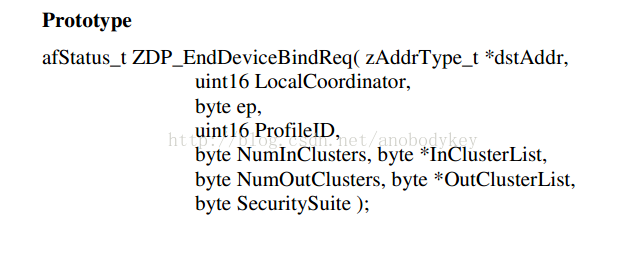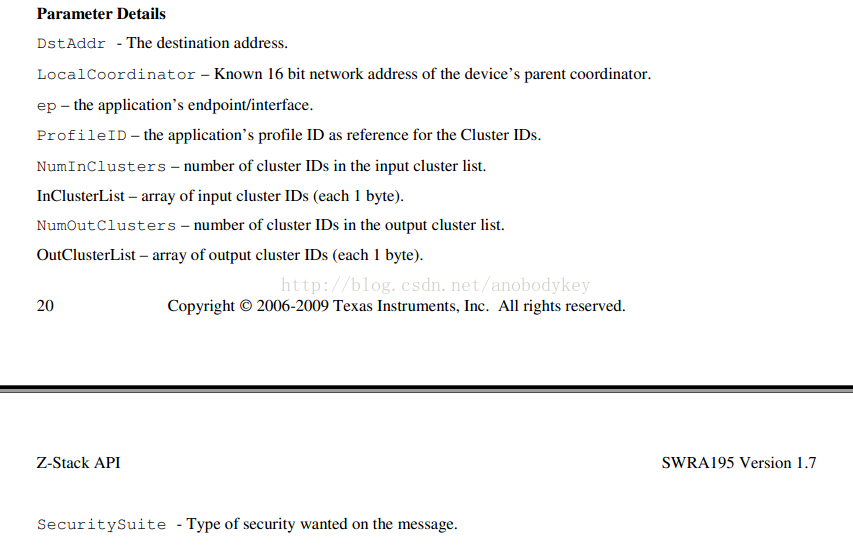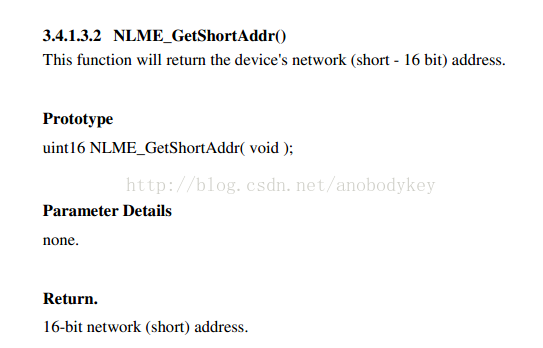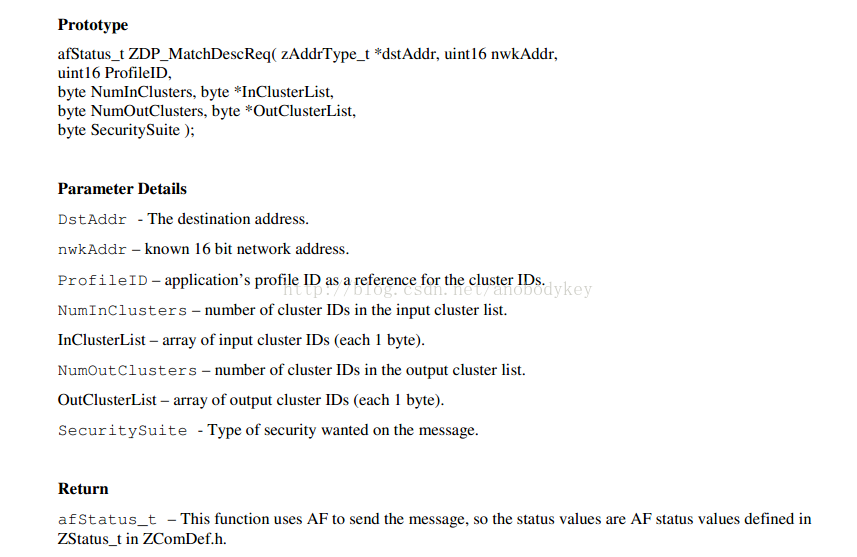协议栈版本:ZSTack-CC2530-2.3.0-1.4.0
IAR:8.10
最近根据例程做过一些实验和改动,觉得学习ZigBee难度不大了,可是细看代码之后觉得还是有些不懂之处,学无止境那。。。
/*********************************************************************
This application isn't intended to do anything useful, it is
intended to be a simple example of an application's structure.
This application sends "Hello World" to another "Generic"
application every 15 seconds. The application will also
receive "Hello World" packets.
The "Hello World" messages are sent/received as MSG type message.
This applications doesn't have a profile, so it handles everything
directly - itself.
Key control:
SW1:
SW2: initiates end device binding
SW3:
SW4: initiates a match description request
*********************************************************************/
/*********************************************************************
* INCLUDES
*/
#include "OSAL.h"
#include "AF.h"
#include "ZDApp.h"
#include "ZDObject.h"
#include "ZDProfile.h"
#include "GenericApp.h"
#include "DebugTrace.h"
#if !defined( WIN32 )
#include "OnBoard.h"
#endif
/* HAL */
#include "hal_lcd.h"
#include "hal_led.h"
#include "hal_key.h"
#include "hal_uart.h"
/*********************************************************************
* MACROS
*/
/*********************************************************************
* CONSTANTS
*/
/*********************************************************************
* TYPEDEFS
*/
/*********************************************************************
* GLOBAL VARIABLES
*/
// This list should be filled with Application specific Cluster IDs.
const cId_t GenericApp_ClusterList[GENERICAPP_MAX_CLUSTERS] =
{
GENERICAPP_CLUSTERID
};
const SimpleDescriptionFormat_t GenericApp_SimpleDesc =
{
GENERICAPP_ENDPOINT, // int Endpoint;
GENERICAPP_PROFID, // uint16 AppProfId[2];
GENERICAPP_DEVICEID, // uint16 AppDeviceId[2];
GENERICAPP_DEVICE_VERSION, // int AppDevVer:4;
GENERICAPP_FLAGS, // int AppFlags:4;
GENERICAPP_MAX_CLUSTERS, // byte AppNumInClusters;
(cId_t *)GenericApp_ClusterList, // byte *pAppInClusterList;
GENERICAPP_MAX_CLUSTERS, // byte AppNumInClusters;
(cId_t *)GenericApp_ClusterList // byte *pAppInClusterList;
};
// This is the Endpoint/Interface description. It is defined here, but
// filled-in in GenericApp_Init(). Another way to go would be to fill
// in the structure here and make it a "const" (in code space). The
// way it's defined in this sample app it is define in RAM.
endPointDesc_t GenericApp_epDesc;
/*********************************************************************
* EXTERNAL VARIABLES
*/
/*********************************************************************
* EXTERNAL FUNCTIONS
*/
/*********************************************************************
* LOCAL VARIABLES
*/
byte GenericApp_TaskID; // Task ID for internal task/event processing
// This variable will be received when
// GenericApp_Init() is called.
devStates_t GenericApp_NwkState;
byte GenericApp_TransID; // This is the unique message ID (counter)
afAddrType_t GenericApp_DstAddr;
/*********************************************************************
* LOCAL FUNCTIONS
*/
void GenericApp_ProcessZDOMsgs( zdoIncomingMsg_t *inMsg );
void GenericApp_HandleKeys( byte shift, byte keys );
void GenericApp_MessageMSGCB( afIncomingMSGPacket_t *pckt );
void GenericApp_SendTheMessage( void );
/*********************************************************************
* NETWORK LAYER CALLBACKS
*/
/*********************************************************************
* PUBLIC FUNCTIONS
*/
/*********************************************************************
* @fn GenericApp_Init
*
* @brief Initialization function for the Generic App Task.
* This is called during initialization and should contain
* any application specific initialization (ie. hardware
* initialization/setup, table initialization, power up
* notificaiton ... ).
*
* @param task_id - the ID assigned by OSAL. This ID should be
* used to send messages and set timers.
*
* @return none
*/
void GenericApp_Init( byte task_id )
{
GenericApp_TaskID = task_id;
GenericApp_NwkState = DEV_INIT;
GenericApp_TransID = 0;
// Device hardware initialization can be added here or in main() (Zmain.c).
// If the hardware is application specific - add it here.
// If the hardware is other parts of the device add it in main().
GenericApp_DstAddr.addrMode = (afAddrMode_t)AddrNotPresent;
GenericApp_DstAddr.endPoint = 0;
GenericApp_DstAddr.addr.shortAddr = 0;
// Fill out the endpoint description.
GenericApp_epDesc.endPoint = GENERICAPP_ENDPOINT;
GenericApp_epDesc.task_id = &GenericApp_TaskID;
GenericApp_epDesc.simpleDesc
= (SimpleDescriptionFormat_t *)&GenericApp_SimpleDesc;
GenericApp_epDesc.latencyReq = noLatencyReqs;
// Register the endpoint description with the AF
afRegister( &GenericApp_epDesc );
// Register for all key events - This app will handle all key events
RegisterForKeys( GenericApp_TaskID );
// Update the display
#if defined ( LCD_SUPPORTED )
HalLcdWriteString( "GenericApp", HAL_LCD_LINE_1 );
#endif
ZDO_RegisterForZDOMsg( GenericApp_TaskID, End_Device_Bind_rsp );
ZDO_RegisterForZDOMsg( GenericApp_TaskID, Match_Desc_rsp );
}
/*********************************************************************
* @fn GenericApp_ProcessEvent
*
* @brief Generic Application Task event processor. This function
* is called to process all events for the task. Events
* include timers, messages and any other user defined events.
*
* @param task_id - The OSAL assigned task ID.
* @param events - events to process. This is a bit map and can
* contain more than one event.
*
* @return none
*/
UINT16 GenericApp_ProcessEvent( byte task_id, UINT16 events )
{
afIncomingMSGPacket_t *MSGpkt;
afDataConfirm_t *afDataConfirm;
// Data Confirmation message fields
byte sentEP;
ZStatus_t sentStatus;
byte sentTransID; // This should match the value sent
(void)task_id; // Intentionally unreferenced parameter
if ( events & SYS_EVENT_MSG )
{
MSGpkt = (afIncomingMSGPacket_t *)osal_msg_receive( GenericApp_TaskID );
while ( MSGpkt )
{
switch ( MSGpkt->hdr.event )
{
case ZDO_CB_MSG:
GenericApp_ProcessZDOMsgs( (zdoIncomingMsg_t *)MSGpkt );
break;
case KEY_CHANGE:
GenericApp_HandleKeys( ((keyChange_t *)MSGpkt)->state, ((keyChange_t *)MSGpkt)->keys );
break;
case AF_DATA_CONFIRM_CMD:
// This message is received as a confirmation of a data packet sent.
// The status is of ZStatus_t type [defined in ZComDef.h]
// The message fields are defined in AF.h
afDataConfirm = (afDataConfirm_t *)MSGpkt;
sentEP = afDataConfirm->endpoint;
sentStatus = afDataConfirm->hdr.status;
sentTransID = afDataConfirm->transID;
(void)sentEP;
(void)sentTransID;
// Action taken when confirmation is received.
if ( sentStatus != ZSuccess )
{
// The data wasn't delivered -- Do something
}
break;
case AF_INCOMING_MSG_CMD:
GenericApp_MessageMSGCB( MSGpkt );
break;
case ZDO_STATE_CHANGE:
GenericApp_NwkState = (devStates_t)(MSGpkt->hdr.status);
if ( (GenericApp_NwkState == DEV_ZB_COORD)
|| (GenericApp_NwkState == DEV_ROUTER)
|| (GenericApp_NwkState == DEV_END_DEVICE) )
{
// Start sending "the" message in a regular interval.
osal_start_timerEx( GenericApp_TaskID,
GENERICAPP_SEND_MSG_EVT,
GENERICAPP_SEND_MSG_TIMEOUT );
}
break;
default:
break;
}
// Release the memory
osal_msg_deallocate( (uint8 *)MSGpkt );
// Next
MSGpkt = (afIncomingMSGPacket_t *)osal_msg_receive( GenericApp_TaskID );
}
// return unprocessed events
return (events ^ SYS_EVENT_MSG);
}
// Send a message out - This event is generated by a timer
// (setup in GenericApp_Init()).
if ( events & GENERICAPP_SEND_MSG_EVT )
{
// Send "the" message
GenericApp_SendTheMessage();
// Setup to send message again
osal_start_timerEx( GenericApp_TaskID,
GENERICAPP_SEND_MSG_EVT,
GENERICAPP_SEND_MSG_TIMEOUT );
// return unprocessed events
return (events ^ GENERICAPP_SEND_MSG_EVT);
}
// Discard unknown events
return 0;
}
/*********************************************************************
* Event Generation Functions
*/
/*********************************************************************
* @fn GenericApp_ProcessZDOMsgs()
*
* @brief Process response messages
*
* @param none
*
* @return none
*/
void GenericApp_ProcessZDOMsgs( zdoIncomingMsg_t *inMsg )
{
switch ( inMsg->clusterID )
{
case End_Device_Bind_rsp:
if ( ZDO_ParseBindRsp( inMsg ) == ZSuccess )
{
// Light LED
HalLedSet( HAL_LED_4, HAL_LED_MODE_ON );
}
#if defined(BLINK_LEDS)
else
{
// Flash LED to show failure
HalLedSet ( HAL_LED_4, HAL_LED_MODE_FLASH );
}
#endif
break;
case Match_Desc_rsp:
{
ZDO_ActiveEndpointRsp_t *pRsp = ZDO_ParseEPListRsp( inMsg );
if ( pRsp )
{
if ( pRsp->status == ZSuccess && pRsp->cnt )
{
GenericApp_DstAddr.addrMode = (afAddrMode_t)Addr16Bit;
GenericApp_DstAddr.addr.shortAddr = pRsp->nwkAddr;
// Take the first endpoint, Can be changed to search through endpoints
GenericApp_DstAddr.endPoint = pRsp->epList[0];
// Light LED
HalLedSet( HAL_LED_4, HAL_LED_MODE_ON );
}
osal_mem_free( pRsp );
}
}
break;
}
}
/*********************************************************************
* @fn GenericApp_HandleKeys
*
* @brief Handles all key events for this device.
*
* @param shift - true if in shift/alt.
* @param keys - bit field for key events. Valid entries:
* HAL_KEY_SW_4
* HAL_KEY_SW_3
* HAL_KEY_SW_2
* HAL_KEY_SW_1
*
* @return none
*/
void GenericApp_HandleKeys( byte shift, byte keys )
{
zAddrType_t dstAddr;
// Shift is used to make each button/switch dual purpose.
if ( shift )
{
if ( keys & HAL_KEY_SW_1 )
{
}
if ( keys & HAL_KEY_SW_2 )
{
}
if ( keys & HAL_KEY_SW_3 )
{
}
if ( keys & HAL_KEY_SW_4 )
{
}
}
else
{
if ( keys & HAL_KEY_SW_1 )
{
}
if ( keys & HAL_KEY_SW_2 )
{
HalLedSet ( HAL_LED_4, HAL_LED_MODE_OFF );
// Initiate an End Device Bind Request for the mandatory endpoint
dstAddr.addrMode = Addr16Bit;
dstAddr.addr.shortAddr = 0x0000; // Coordinator
ZDP_EndDeviceBindReq( &dstAddr, NLME_GetShortAddr(),
GenericApp_epDesc.endPoint,
GENERICAPP_PROFID,
GENERICAPP_MAX_CLUSTERS, (cId_t *)GenericApp_ClusterList,
GENERICAPP_MAX_CLUSTERS, (cId_t *)GenericApp_ClusterList,
FALSE );
}
if ( keys & HAL_KEY_SW_3 )
{
}
if ( keys & HAL_KEY_SW_4 )
{
HalLedSet ( HAL_LED_4, HAL_LED_MODE_OFF );
// Initiate a Match Description Request (Service Discovery)
dstAddr.addrMode = AddrBroadcast;
dstAddr.addr.shortAddr = NWK_BROADCAST_SHORTADDR;
ZDP_MatchDescReq( &dstAddr, NWK_BROADCAST_SHORTADDR,
GENERICAPP_PROFID,
GENERICAPP_MAX_CLUSTERS, (cId_t *)GenericApp_ClusterList,
GENERICAPP_MAX_CLUSTERS, (cId_t *)GenericApp_ClusterList,
FALSE );
}
}
}
/*********************************************************************
* LOCAL FUNCTIONS
*/
/*********************************************************************
* @fn GenericApp_MessageMSGCB
*
* @brief Data message processor callback. This function processes
* any incoming data - probably from other devices. So, based
* on cluster ID, perform the intended action.
*
* @param none
*
* @return none
*/
void GenericApp_MessageMSGCB( afIncomingMSGPacket_t *pkt )
{
switch ( pkt->clusterId )
{
case GENERICAPP_CLUSTERID:
// "the" message
#if defined( LCD_SUPPORTED )
HalLcdWriteScreen( (char*)pkt->cmd.Data, "rcvd" );
#elif defined( WIN32 )
WPRINTSTR( pkt->cmd.Data );
#endif
break;
}
}
/*********************************************************************
* @fn GenericApp_SendTheMessage
*
* @brief Send "the" message.
*
* @param none
*
* @return none
*/
void GenericApp_SendTheMessage( void )
{
char theMessageData[] = "Hello World";
if ( AF_DataRequest( &GenericApp_DstAddr, &GenericApp_epDesc,
GENERICAPP_CLUSTERID,
(byte)osal_strlen( theMessageData ) + 1,
(byte *)&theMessageData,
&GenericApp_TransID,
AF_DISCV_ROUTE, AF_DEFAULT_RADIUS ) == afStatus_SUCCESS )
{
// Successfully requested to be sent.
}
else
{
// Error occurred in request to send.
}
}
/*********************************************************************
*********************************************************************/
该程序是一个协调器和终端互发“Hello World”的例子,例程开头是一个簇列表的ID,不过目前我还不晓得这个簇是用来做什么的,看过一些资料说是用来包容属性的,在逻辑上使用簇来通信,望大牛来解答疑惑,接着是一个简单描述符
const SimpleDescriptionFormat_t GenericApp_SimpleDesc =
{
GENERICAPP_ENDPOINT, // int Endpoint;
GENERICAPP_PROFID, // uint16 AppProfId[2];
GENERICAPP_DEVICEID, // uint16 AppDeviceId[2];
GENERICAPP_DEVICE_VERSION, // int AppDevVer:4;
GENERICAPP_FLAGS, // int AppFlags:4;
GENERICAPP_MAX_CLUSTERS, // byte AppNumInClusters;
(cId_t *)GenericApp_ClusterList, // byte *pAppInClusterList;
GENERICAPP_MAX_CLUSTERS, // byte AppNumInClusters;
(cId_t *)GenericApp_ClusterList // byte *pAppInClusterList;
};这里输入簇和输出簇用的同一个列表,依然未懂。。。
在初始化函数中对一些数据进行了初始化并注册了两个ZDO信息
ZDO_RegisterForZDOMsg( GenericApp_TaskID, End_Device_Bind_rsp );
ZDO_RegisterForZDOMsg( GenericApp_TaskID, Match_Desc_rsp );一个是节点设备 的绑定响应,一个是响应匹配描述符请求。
在GenericApp_ProcessEvent()函数中对消息进行处理,ZDO_CB_MSG对应着上面我们注册的两个ZDO信息,KEY_CHANGE即按键处理,AF_DATA_CONFIRM_CMD是无线数据确认包,当我们在AF_DataRequest()函数的options参数中添加了AF_ACK_REQUEST标志时,会进入这里,AF_INCOMING_MSG_CMD即有无线消息接收,ZDO_STATE_CHANGE网络状态改变,GenericApp_ProcessEvent()函数会去读取事件,遍历所有事件直到结束,在网络状态发生改变时,用到了osal_start_timerEx()函数,定时器,定时5秒钟置位发送信息事件,这样就可以在这里检测是否该事件被置位,如果置位则进行发送信息函数,每隔5s发送“Hello World”,
if ( events & GENERICAPP_SEND_MSG_EVT )
{
// Send "the" message
GenericApp_SendTheMessage();
// Setup to send message again
osal_start_timerEx( GenericApp_TaskID,
GENERICAPP_SEND_MSG_EVT,
GENERICAPP_SEND_MSG_TIMEOUT );
// return unprocessed events
return (events ^ GENERICAPP_SEND_MSG_EVT);
}在该函数中比较主要的是按键处理,用的是S2和S4两个按键,当所按按键是S2时,则执行终端绑定函数ZDP_EndDeviceBindReq(),该函数将建立和发送一个终端设备绑定请求(“手动绑定”)。可以发送该信息来尝试一个设备的手动绑定功能,手动绑定之后你可以给协调器发送一个间接(无地址)信息,协调器将把该信息发送至绑定了该信息的设备,然后你就可以从新绑定的设备接收信息了。(从中可以看出绑定信息请求只能由协调器来接收处理),在该例程中终端设备是绑定协调器,绑定函数原型如下


关于第二个参数有些不明白,在函数说明中LocalCoordinator是已知的16位网络地址的设备的父节点协调器,而在传参数时是传递的是NLME_GetShortAddr(),而该地址是设备的地址,原型如下

希望日后可以明白吧。。。
当所按按键是S4时即执行ZDP_MatchDescReq()函数,改调用将建立和发送一个匹配描述请求,使用这个函数查询与应用程序输入簇和输出簇列表相匹配的设备或应用程序,该函数原型如下

在例程中网络地址是广播地址,也就是面向全网发送,但由于只有一个协调器和一个节点在网络中,则肯定会由协调器来响应这个请求了。。。
AF_DATA_CONFIRM_CMD可以先忽略,因为没有用到,查看ZDO_CB_MSG的处理函数,在该处理中我们接收我们注册的两个ZDO信息(注:一直没搞明白,同一个代码用两种配置:EndDeviceEB、CoordinatorEB,代码分析起来不晓得站在哪个角度来分析:协调器角度?节点角度?路由角度?亦或每个角度都分析)在GenericApp_ProcessZDOMsgs()函数中,对消息的clusterID进行判断,如果是End_Device_Bind_rsp,这个肯定是节点设备才需要的,设备执行绑定之后会,当协调器也按下S2之后,设备会接收到此消息,对于绑定的原理还没搞清楚。。。惭愧,节点设备收到此信息,则点亮LED4,对于Match_Desc_rsp留到以后分析吧,当绑定执行成功之后,节点和协调器之间就会互发“Hello World”信息,执行GenericApp_SendTheMessage()函数,可以看到是发送一个无地址的间接信息,由于协调器绑定了该设备,则会来接收此消息,接收消息的处理在AF_INCOMING_MSG_CMD中,在LCD上显示接收到来的消息。
至此,GenericApp程序就分析的差不多了,虽然没啥实质性内容,希望可以帮助自己进步。。。^_^
最后
以上就是大力老师最近收集整理的关于ZigBee学习笔记_GenericApp分析的全部内容,更多相关ZigBee学习笔记_GenericApp分析内容请搜索靠谱客的其他文章。








发表评论 取消回复